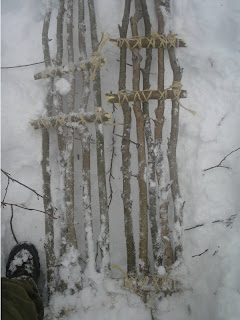Since there isn't much to report from skillswise, I thought I'd give the readers a simple treatise on walking barefooted. Walking barefooted, however looked down upon in our society it has numerous advantages over using shoes. I have done this for several years during the warm season and find it much more comfortable than using shoes.
First on the advantages of going barefeet:
HygieneHaving your feet exposed to water, dirt (which sucks up fats and moisture) and the sun washes, dries and condition your feet automatically. Shoes on the other hand, locks in moisture and promotes bacterial and fungal growth. At first it only creates annoying smells, but in time it can develop into quite dangerous foot-rot. There is a reason why all the rainforest tribes around the world go barefeet. Shoes would never dry up.
Foot healthIf you ever have heard of massaging your feet. That happens all the time when you walk barefeet. Being as close to the ground as practically possible, it almost eliminates the chance of stepping over. It also trains your feet and legs (very much in fact) and toughens up the skin. Blood circulation is increased and that reduces freezing on your feet in winter. Something which I have barely done after I started to walk barefeet almost all the time.
SilenceThere are three reasons why you walk silently without shoes.
- The pain of stepping on something sharp makes you take care when you step (effect is reduced as you toughen though).
- Better contact with the ground, when you feel the sticks directly you can avoid breaking them much easier.
- The sole of the foot is softer than that of the shoe.
EconomyMaybe not so relevant today, but in a time when you needed that leather for winter shoes you would want to save it by walking barefeet in summer. Modern shoes may not wear out so quickly, but moccasins, birch bark shoes and other natural shoes do. So, if you are going primitive for a longer period of time, you more than likely need to learn yourself to walk barefeet.
LimitiationsLike a heavily used horse, a human trekking for multiple days with a backpack over rough country and without rest will need some sort of shoe to avoid wearing down the sole underneath. The sole will regenerate, but you need to rest for that to happen. You will also need shoes on very hot sand, where there are a lot of thorns and in the snow. There are plenty of ethnographic examples that defy all of these, so it isn't written in stone.
Getting tough feetTough feet are unfortunately impossible to buy in a shop. Every spring I do this, as my feet has pretty much reverted by then. It will not revert all the way though, so it will not take as long as the first every time.
If you have extremely tender feet, start on grass and coarse sand. Walk around all day on this soft ground for several days, it should make your feet sore. Dont' bother resting after this small ordeal, but press on. On the days that come, start walking on very coarse asphalt and coarse gravel. That will be very painful and your feet will be very sore. When it gets so bad that you feel like tendons are pulling all over the place and blisters are forming. Take two days with shoes on.
After the rest, start walking everywhere without shoes. Especially in the forest, where the ling will whip the soft parts on top of the feet and toughen them too. Take two days with shoes whenever you feel blisters forming.
As you continue walking barefeet it will become second nature to you and you will loose your fear of stepping on something sharp and become able to run, even in the forest.


















































